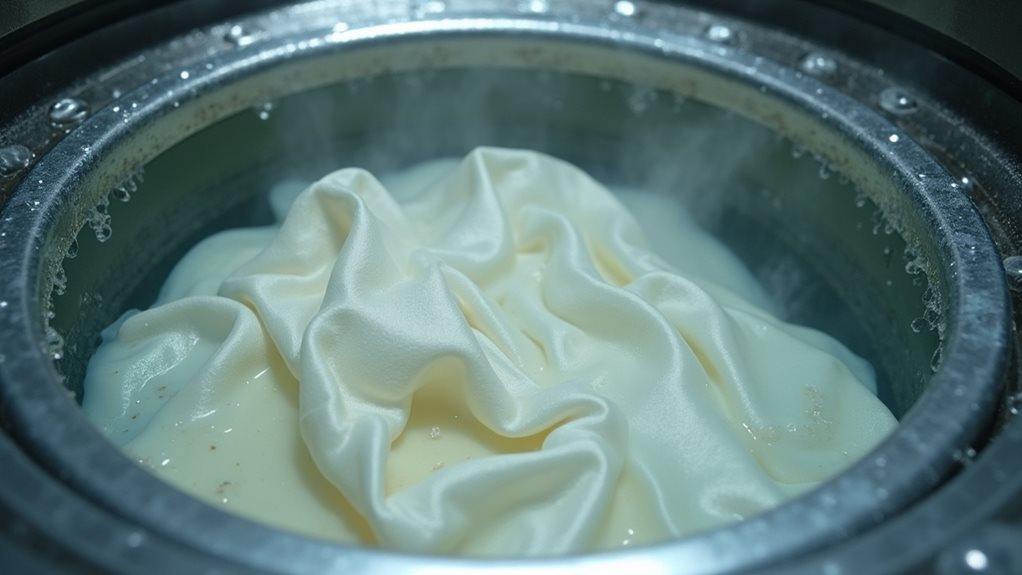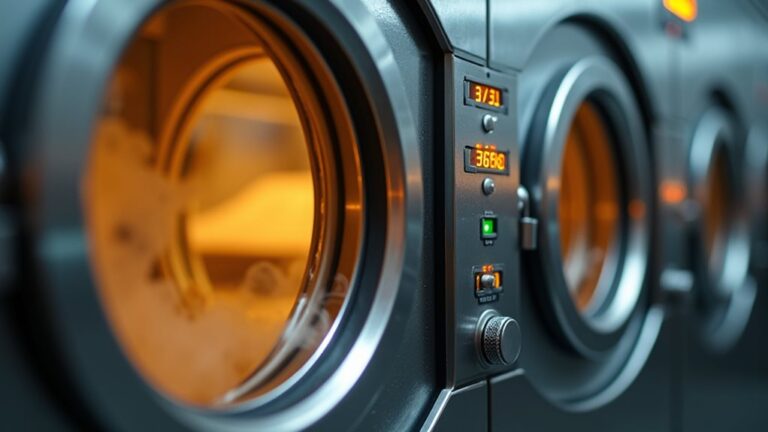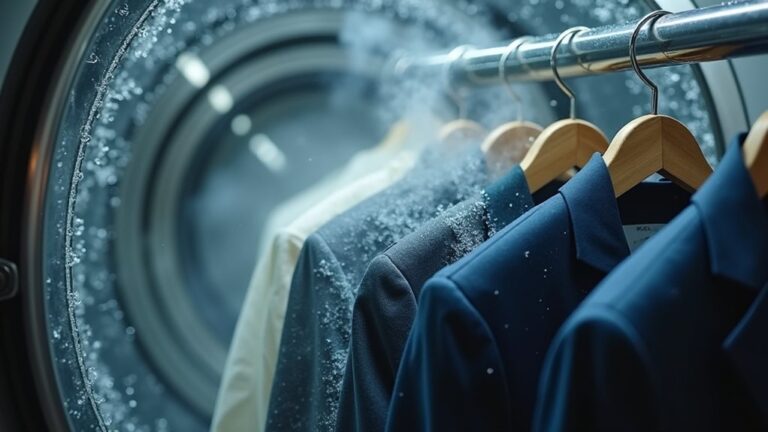When you drop off that silk blouse or wool suit, dry cleaners work their magic using chemical solvents like perchloroethylene instead of water, which would damage delicate fabrics. These powerful solvents dissolve oil-based stains and grease while preserving your garment’s shape and texture through a careful process of pre-treatment, solvent washing, and professional pressing. It’s honestly fascinating how they can make your clothes look brand new again, and there’s so much more happening behind those curtains.
What Is Dry Cleaning?
The mystery of dry cleaning unraveled for me during my first week at a corporate job, when I frantically googled “how to clean silk blouse” at 6 AM after spilling coffee on my only professional shirt.
Here’s what I discovered: the dry cleaning process doesn’t actually use water at all—it relies on chemical solvents, primarily perchloroethylene, to dissolve grease stains and oil-based messes that would ruin delicate fabrics in your washing machine.
Professional cleaning machines gently bathe your garments in these solvents, while skilled cleaners handle pre-treating stubborn stains before the main wash.
The finishing process includes steaming, pressing, and a final inspection step to verify everything looks perfect.
This method is particularly essential for structured garments like suits and formal wear, as it prevents shrinkage and fabric damage while maintaining the garment’s original shape.
It’s basically fabric surgery!
The Science Behind Dry Cleaning Solvents
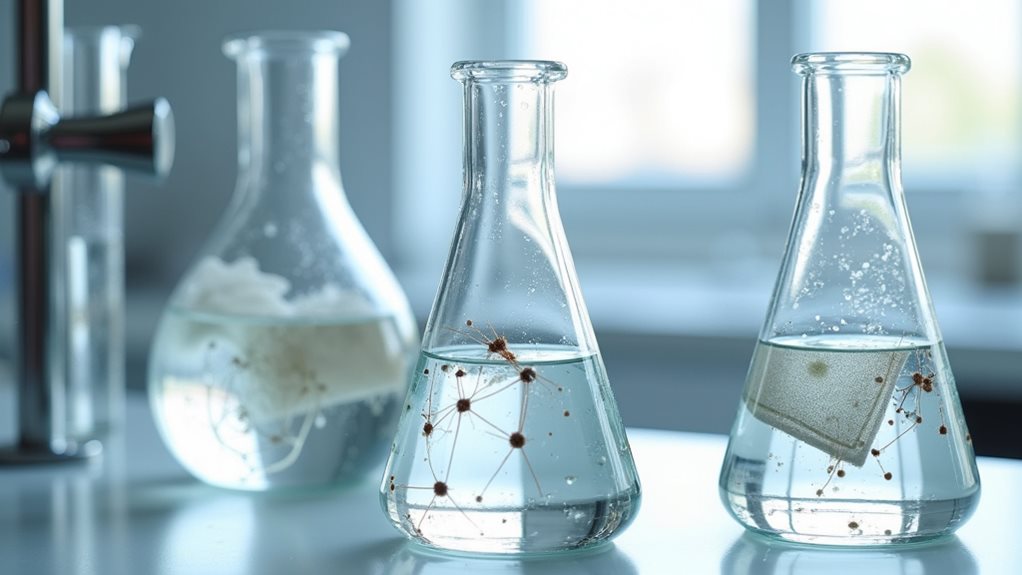
You’ve probably wondered why your favorite silk blouse comes back spotless from the dry cleaner when your home washing attempts left it looking like a sad, shrunken mess—well, it’s all about the magical chemistry of solvents that work completely differently than water.
These specialized cleaning liquids, from the traditional perchloroethylene to newer eco-friendly alternatives like liquid CO2, have unique molecular properties that let them slip into fabric fibers and grab onto stubborn stains without causing the drama that water creates.
Understanding how these solvents actually work, what types are available, and yes, the safety concerns that come with them (because let’s be honest, some of these chemicals aren’t exactly something you’d want to sip with your morning coffee ☕), will help you make smarter choices about your garment care.
The industry has relied on PERC as the standard solvent for decades because of its exceptional ability to remove oils and greases while keeping delicate fabrics intact.
How Solvents Work
Behind every spotless silk blouse and perfectly pressed wool suit lies a fascinating chemical dance that most of us never think about, though understanding how dry cleaning solvents work can make you appreciate why your delicate garments come back looking like new.
When you drop off that wine-stained blazer, dry cleaning solvents like perchloroethylene target oil-based stains while leaving water-based stains untouched—it’s selective chemistry at work.
The cleaning process tumbles your delicate fabrics in these non-polar compounds, which penetrate fibers without causing the swelling that water creates.
Advanced dry cleaning machines recycle 99.99% of solvents, making the process surprisingly eco-conscious.
While petroleum spirits and other hydrocarbon-based solvents have also been employed in dry cleaning operations, they offer varying degrees of effectiveness compared to traditional options.
Alternative solvents and environmentally friendly solvents are emerging too, proving that effective cleaning doesn’t require sacrificing safety—your grandmother’s favorite coat can stay pristine!
Types of Solvents
While solvents work their magic through chemical principles, choosing the right one for your precious garments depends on understanding what each type brings to the cleaning table.
Trust me, after years of watching my favorite cashmere sweater survive countless cleanings, I’ve learned that not all solvents are created equal. Perchloroethylene remains the industry standard, effectively tackling oil-based stains despite environmental concerns.
Alternative solvents like liquid carbon dioxide offer impressive eco-friendly practices without compromising cleaning efficiency, though they’re pricier.
Silicone-based solvents treat delicate fabrics with remarkable gentleness, breaking down into harmless components. These non-polar solvents excel because they dissolve oils without penetrating fibers, protecting your investment pieces while minimizing environmental impact through smarter chemistry.
Hydrocarbon solvents provide another gentler alternative that reduces environmental impact while still delivering effective cleaning results for most garments.
Solvent Safety Concerns
Although solvent effectiveness dominates most conversations about dry cleaning, the elephant in the room remains the very real health and environmental concerns that have shadowed this industry for decades.
Honestly, it took me years to fully grasp why my local cleaner switched from their traditional setup to those fancy new machines. Perchloroethylene, the go-to solvent since the 1930s, carries carcinogenic risks that you shouldn’t ignore, even though occupational exposure typically stays below dangerous thresholds.
Smart shop owners are embracing alternative solvents like liquid carbon dioxide and eco-friendly options including siloxane, responding to regulatory frameworks from the EPA that push for safer dry cleaning methods.
These innovations reduce environmental impact while protecting workers’ health, proving that effective cleaning doesn’t require compromising safety. Consumer awareness about PERC residues remaining on freshly cleaned garments has also driven demand for these safer alternatives, especially for clothing worn close to the skin.
Step-by-Step Dry Cleaning Process
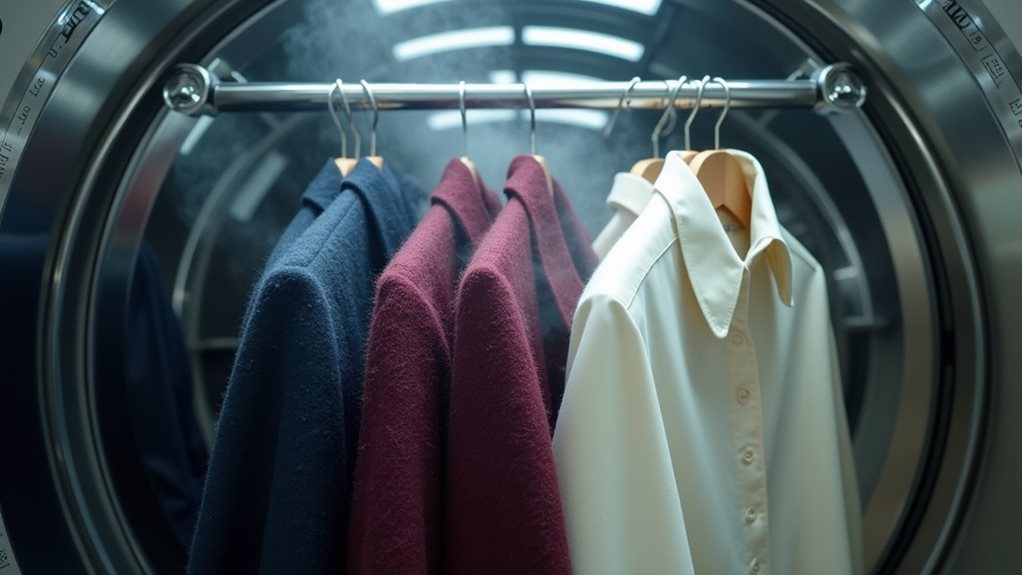
When you drop off your favorite silk blouse at the dry cleaner, you’re probably wondering what magical process transforms that coffee-stained mess back into something you’d actually wear to your boss’s dinner party 😅.
The expedition your garment takes involves two essential phases that I’ve watched countless times during my own dry cleaning adventures: a meticulous initial inspection where every stain gets catalogued like evidence at a crime scene, followed by the actual solvent cleaning that works like a gentle chemical bath for your clothes.
Understanding these steps helped me realize why my grandmother always insisted on pointing out every single spot to the clerk, even though I used to roll my eyes at her thoroughness.
After the cleaning phase, your garments go through solvent extraction where the cleaning solution is carefully distilled and recycled for future use.
Initial Inspection and Tagging
Before your favorite blazer disappears into the mysterious world of dry cleaning machinery, it undergoes a thorough inspection process that’s honestly more detailed than most medical checkups I’ve received 😅.
During this initial inspection, each garment receives a unique identification number for proper tracking throughout the entire process, which honestly puts my own organizational skills to shame.
The staff carefully examines your clothes for pre-existing damages, documents any stains they discover, and identifies delicate fabrics that’ll need special handling or specific cleaning techniques.
Think of it as creating a personalized treatment plan for your garments, guaranteeing they receive exactly what they need rather than a one-size-fits-all approach that could damage your investment pieces.
This detailed assessment also involves checking care labels to determine the appropriate solvents and methods that will safely clean each specific fabric type without causing damage.
Solvent Cleaning and Finishing
Once your garments have been properly inspected and tagged, they enter the heart of the dry cleaning process where the real magic happens, and honestly, watching this transformation never gets old for me.
Your clothes get gently placed into specialized machines where they’re bathed in cleaning solvent—usually perchloroethylene or an eco-friendly alternative that’s much kinder to our planet 🌍. This solvent works brilliantly on delicate fabrics, dissolving oils and dirt that water simply can’t touch.
After the cleaning cycle completes, there’s another thorough inspection to verify those stubborn stains have vanished completely.
The solvent is filtered and distilled for reuse while your garments go through a drying cycle where any remaining solvent evaporates completely.
Then comes my favorite part—the finishing stage, where your garments are steamed, pressed, and carefully wrapped in protective plastic bags, ready for their grand return to your closet.
Types of Fabrics That Benefit From Dry Cleaning

While you might think all fabrics are created equal, I learned the hard way that some materials practically beg for the gentle touch of dry cleaning – and trust me, my shrunken cashmere sweater from college still haunts my closet as a reminder 😅.
Delicate fabrics like silk, wool, and cashmere maintain their luxurious texture when you choose this specialized cleaning method over water-based washing.
Water and delicate fabrics don’t mix – dry cleaning preserves the soft, luxurious feel that makes these materials so special.
Specialty materials such as rayon and velvet preserve their shape and color integrity through dry cleaning’s gentle solvents. Your garments with intricate embellishments, like sequined dresses, won’t suffer water damage during the process.
Even synthetic fibers labeled “dry clean only” benefit from this approach, while leather and suede items require these specialized solvents to effectively remove dirt without warping.
This professional approach helps extend the lifespan of your expensive garments while maintaining their pristine condition through chemical solvents that remove stains without causing damage or shrinkage.
Advantages and Limitations of Dry Cleaning
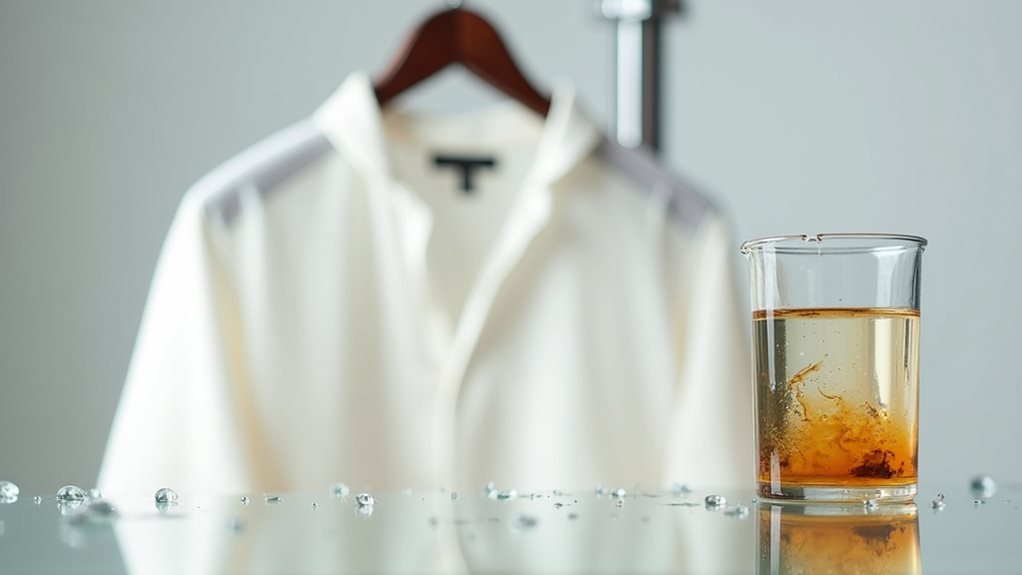
Now that you know which fabrics thrive with dry cleaning, you’ll want to understand both the remarkable benefits and honest drawbacks of this specialized process before you commit your favorite garments to professional care.
The advantages are genuinely impressive – dry cleaning preserves your delicate fabrics‘ shape and texture while those specialized solvents tackle oil-based stains that’d laugh at regular washing methods. You’ll also get sanitization through dry heat, which I’ve found particularly reassuring during flu season 😷. Professional pressing and finishing techniques used by dry cleaners create a crisp, polished look that’s nearly impossible to achieve with home washing methods.
However, the limitations are real: water-based stains often survive the process, and traditional solvents create environmental concerns that honestly keep me up at night sometimes.
Thankfully, eco-friendly alternatives are emerging, though they’re still finding their footing compared to conventional cleaning methods.
Environmental Impact and Green Alternatives

Although I’ve always considered myself environmentally conscious, I’ll admit that learning about traditional dry cleaning’s impact made me wince harder than stepping on a LEGO barefoot 😬.
The dry cleaning industry’s reliance on perchloroethylene creates serious environmental impact through groundwater contamination and air pollution, which honestly shocked me more than finding out my favorite childhood cereal was mostly sugar.
Fortunately, green alternatives are transforming the environment, and you’ve got fantastic options now.
Green dry cleaning alternatives are revolutionizing the industry, giving you amazing eco-friendly choices that actually work.
Eco-friendly dry cleaning methods like liquid carbon dioxide cleaning and wet cleaning eliminate toxic chemical use entirely, while energy-efficient machines recycle solvents to minimize waste.
The ongoing innovations in solvent technology mean you can keep your clothes pristine without compromising your values or our planet’s health.
Maximizing Results From Professional Dry Cleaning Services
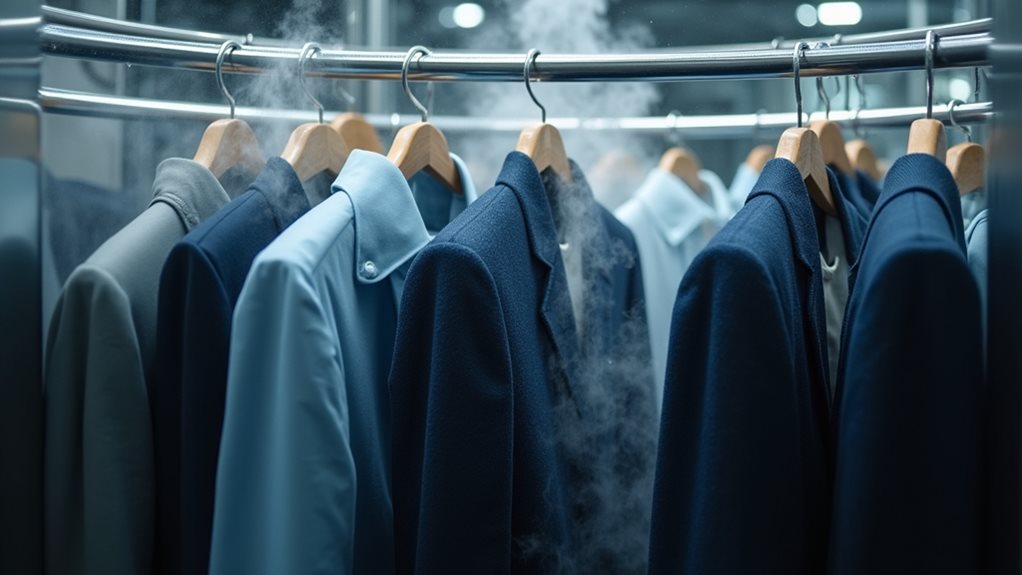
Since you’ve made the smart choice to invest in professional dry cleaning, let me share some hard-earned wisdom that’ll help you get every penny’s worth from these services.
Those garment care labels aren’t suggestions—they’re your roadmap to preserving expensive clothing, and I learned this the hard way after ruining a silk blouse with home treatment 😅.
When dropping off items, tell your cleaner exactly what caused each stain, because targeted pre-treatment works miracles on red wine versus grease.
Don’t overwhelm them with multiple heavily soiled pieces at once, as this impacts cleaning efficiency.
Always mention concerns about delicate fabrics or embellishments—these professionals adjust their process accordingly.

